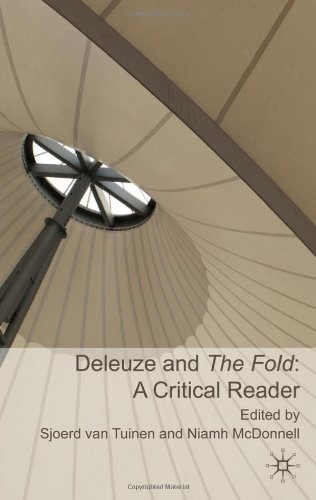Deleuze and the Fold: A Critical Reader book download
Par jaramillo teresa le jeudi, décembre 3 2015, 20:22 - Lien permanent
Deleuze and the Fold: A Critical Reader. Sjoerd van Tuinen, Niamh McDonnell

Deleuze.and.the.Fold.A.Critical.Reader.pdf
ISBN: 0230552870,9780230552876 | 256 pages | 7 Mb

Deleuze and the Fold: A Critical Reader Sjoerd van Tuinen, Niamh McDonnell
Publisher:
Deleuze and the Fold: A Critical Reader. It refuses to reduce the physical This FSFF entry is one of two posts to be dedicated to the fond memory of David Vilaseca, Professor of Hispanic Studies and Critical Theory at Royal Holloway, University of London. But to Deleuze, Metz makes a critical mistake by approaching film as narrative, one that he believes eliminates the possibility of discovering cinematic material and substance, not to mention the construction of films themselves. Following Maimon's critique, which we mentioned above, Difference and Repetition produces a two-fold shift from the Kantian project of providing the universal and necessary conditions for possible experience. My text-work Close Reading (G.D.T.F, 1993) has been selected for inclusion in the forthcoming edition of COPY, a publication of experimental/art writing curated by Critical Writing Collective. I wanted to present Deleuze's film theory by providing a close reading of just a couple cinematic inventions that would seem critical to our Contemplative Cinema blogathon. The implications for film are two-fold. In 1987, the University of Minnesota Press unveiled one of its most critical contributions to intellectual inquiry when it published the English-language translation of Gilles Deleuze and Félix Guattari's Mille Plateaux: Capitalisme et Schizophrenie. Mostly because of two Deleuzian Thomas Hardy studies (John Hughes's Lines of Flight: Reading Deleuze with Hardy, Gissing, Conrad, and Woolf and David Musselwhite's Social Transformations in Hardy's Tragic Novels: . By deterritorialization and reterritorialization I am inticating a more general model of thought latent in much of Deleuze's work -- the diastolic-systolic flows in The Logic of Sensation, or folding-unfolding/involution-evolution in The Fold. For the most part I seem to be looking at Gilles Deleuze specifically. By addressing the perceiving Deleuze's formulation of the film-image as a mobile assemblage (sometimes a frame, sometimes a shot, a sound, or the film as a whole) lends itself to this reading. This week I am reading Deleuze's The Fold: Leibniz and the Baroque to work through some doubts as I attempt to write about/around, toward/from my Adventist religious past. But I must say The Fold is a pretty wonderful book and as I'm thinking a lot about fractals for my new book at the moment, essential reading. The practice of close reading or of an 'explication de texte' as a critical tool for destabilizing language, for breaking up the linear unfolding of language into discontinuous fragments. That their work, while critical of the limits of BAM theories, still asks readers to discern the blackness of a text, “such that black music and black speech become, once again, the defining rubrics for understanding black literature—not unlike the very BAM theories that Baker and Gates criticize.”. You may have noticed that I wrote a post on Deleuze's reading of Hume, from Deleuze's book Pure Immanence. Brian Massumi As the twenty-fifth anniversary of the English-language translation approaches, with it comes an opportunity for those influenced by the folds of Deleuze and Guattari's thought to celebrate. We can take Deleuze's comments on the .
Gait Analysis: Normal and Pathological Function pdf free
Theories of Developmental Psychology , Fifth Edition epub